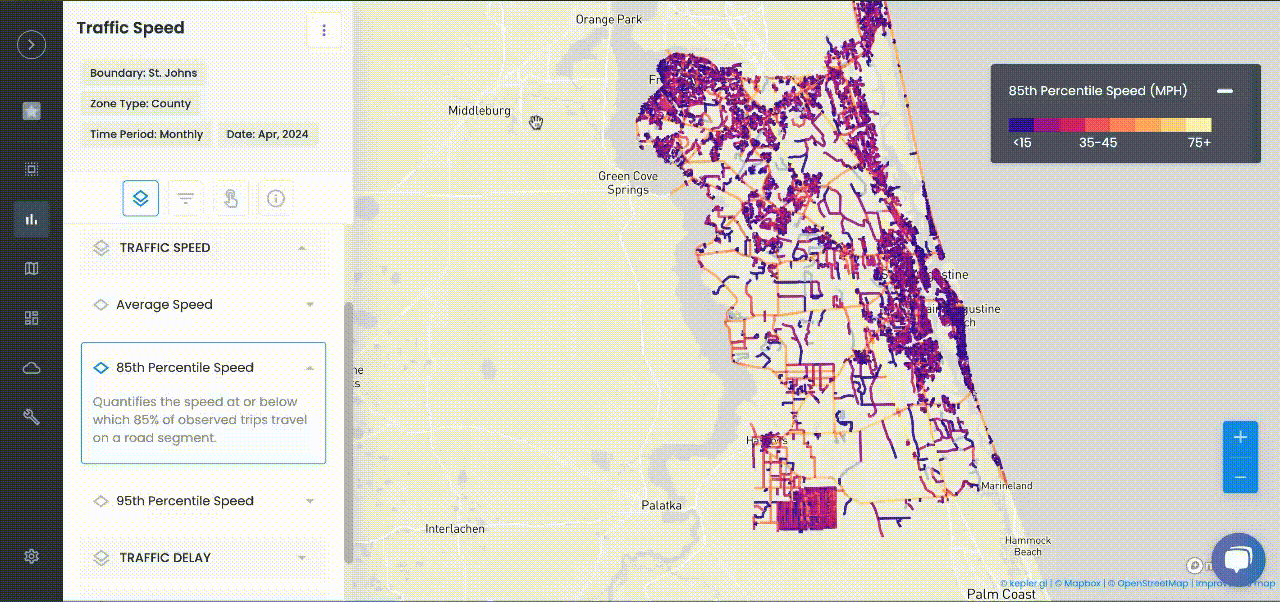
Transportation Planning
AI‑Powered Urban Mobility Forecasting: Adapting City Transportation to Post‑Pandemic Trends
Traffic data is helping cities adapt transit and traffic planning to post-pandemic travel patterns, hybrid work shifts, and real-time demand
The COVID‑19 pandemic upended traditional commuting patterns virtually overnight. In the years since, remote work and flexible schedules have fundamentally changed how people move around cities. Rush‑hour peaks have flattened, transit ridership dropped then slowly rebounded, and many former commuters now travel at different times or not at all on certain days. City transportation agencies are grappling with a new question: how do we plan for transit and road usage in this “new normal” when past trends no longer apply?
This is where AI-powered mobility forecasting comes into play. By leveraging machine learning on vast mobility datasets—from traffic sensors, public transit smart cards, cellphone location data, and more—cities can predict emerging travel patterns and adapt transportation services proactively. AI excels at detecting subtle shifts and combining diverse factors (like remote work rates, school schedules, weather, etc.) to forecast demand. The result is a more responsive transportation network, tuned to post‑pandemic realities.
The Shifting Commute Paradigm
First, it’s important to understand how stark the change has been. Before 2020, only about 5% of U.S. employees worked remotely most of the time. During the pandemic, that spiked above 60%, and even in late 2022, a stable 35–40% of the workforce continued working from home at least one day a week. In practice, many office workers now commute only two or three days per week, often Tuesday through Thursday, with Mondays and Fridays at home.
This hybrid pattern breaks the old mold of five-day-a-week peak commuting. Data confirms the effect: as of early 2025, office occupancy is only ~54% of pre‑pandemic levels on average, yet transit ridership has climbed back to about 85% of pre‑pandemic trips. That means people are using transit and roads for a variety of purposes beyond just going to the office—travel for errands, appointments, or social reasons has filled some of the gap. Weekend and midday ridership are up in many cities, while Monday/Friday rush hours remain lighter. These complex changes are hard to capture with traditional planning models, which is why agencies are embracing big data and AI to continually update their forecasts.
Learning from Data in Real Time
Artificial intelligence can sift through massive, real-time data streams to identify new patterns far faster than manual analysis. For example, machine learning models can ingest public transit fare card swipes, rideshare trip records, bike-share usage, and highway traffic speeds, and then find correlations—perhaps discovering that midday travel between residential suburbs and local retail centers is rising as work-from-home employees go out for lunch or errands.
AI can also factor in external data like COVID case rates, gas prices, or even Zoom meeting statistics to predict how many people will travel. Importantly, these models are not one-time; they continuously learn. If a city observes that every time there’s a major event or a shift in public health guidance more people return to offices, the AI model will incorporate that into forecasts.
This level of real-time modeling aligns with Urban SDK’s mobility intelligence platform, which enables agencies to integrate live data streams—from traffic, transit, and demographic sources—into continuously updating forecasts and dashboards.
Adapting Transit Schedules and Routes
One direct application of AI forecasting is optimizing transit operations for new demand patterns. Instead of running the same number of trains every rush hour, agencies can use AI insights to allocate service when and where it’s needed most. For example, if data shows the 7am downtown express is underutilized but the 11am and 2pm trains are getting crowded (a possible scenario with staggered office hours and hybrid workers), schedules can be tweaked accordingly.
Urban SDK supports this level of decision-making with travel time delay and traffic volume data, helping planners identify when and where congestion builds or transit demand shifts. This data can guide changes in frequency, rerouting, or even the creation of midday microtransit options.
Traffic Management in the Hybrid Era
It’s not just transit—city traffic engineers are also using AI to manage roads amid fluctuating commuting patterns. Traffic volumes dropped significantly in 2020, then rebounded as people avoided transit, and are now finding a new equilibrium. Interestingly, remote work has brought some environmental benefits: one study estimates that each 1% increase in remote work reduces urban transport emissions by ~1.8% as fewer people drive.
However, there are also counter-trends like increased freight and delivery traffic from online shopping and more off-peak car trips. AI-based traffic modeling systems can better predict these flows. For instance, if a city knows that many employees now drive to the office only on Wednesdays, it can adjust traffic signal timing or HOV lane operations on those days specifically.
Urban SDK enables this through real-time traffic speed data and scenario-based modeling tools. Cities can simulate "what-if" scenarios and adjust traffic control strategies dynamically, whether that’s for signal timing or congestion pricing trials.
Case Study – Data-Driven Recovery
A concrete example comes from New York City Transit’s pandemic recovery efforts. The Metropolitan Transportation Authority (MTA) brought in an AI analytics platform to help regain riders and deploy service efficiently. The system ingested millions of data points from bus passenger counters and MetroCard swipes and learned the new usage patterns.
Planners discovered, for example, that some residential routes had different peak times than pre‑2020, so they adjusted timetables. The result was that buses were less often empty or overcrowded—resources were rebalanced to meet actual needs. This type of real-time responsiveness reflects what Urban SDK delivers through our traffic congestion analytics, allowing agencies to match service to demand even as behavior shifts.
In Summary
AI-powered forecasting is becoming an indispensable tool for city transportation planning in the post-pandemic era. Traditional models built on past decades’ habits simply don’t fit a world where remote/hybrid work, on-demand travel, and other flexible arrangements reign.
By using AI to continuously learn from fresh data, cities can detect how travel is evolving—and then respond with nimble adjustments. Urban SDK’s data ecosystem—spanning mobility intelligence, traffic safety, and predictive analytics—helps cities modernize their transportation strategies in line with real-world behavior.
The ultimate benefit is to travelers: buses and trains arrive when needed, traffic flows are smoother, and planners are prepared—not surprised—by new trends.
FAQs
Q1. What is AI-powered urban mobility forecasting?
Ans: AI-powered mobility forecasting uses machine learning to analyze vast data from traffic sensors, public transit card swipes, cellphone location, and more, to predict emerging travel patterns and adapt city transportation services proactively.
Q2. How has the pandemic changed urban commuting patterns?
Ans: The pandemic sharply increased remote and hybrid work, reducing weekday rush-hour peaks and shifting transit and road usage to varied times, including weekends and midday. Many commuters now travel fewer days per week or have flexible schedules.
Q3. Why don’t traditional transportation planning models work well in the post-pandemic world?
Ans: Traditional models rely on historical commuting patterns, which no longer reflect real-world behavior due to hybrid schedules and new travel purposes. These models lack the real-time adaptability enabled by AI and big data.
Q4. How does AI help transportation agencies manage changing demand?
Ans: AI continuously learns from new data to detect shifts in travel behavior - like changes in transit ridership, route popularity, or traffic congestion - and assists agencies in adjusting transit frequency, routes, and traffic management strategies accordingly.
Q5. What new data sources feed AI mobility forecasting models?
Ans: Models ingest diverse sources, including transit smart card usage, ride-share trips, bike-share data, real-time traffic speeds, public health data, weather, and even virtual meeting trends like Zoom usage for deeper insights.
Q6. How are cities using AI to adapt transit schedules post-pandemic?
Ans: By analyzing real-time ridership trends, cities can reduce or increase service at non-peak and peak times, reroute buses to meet new demand, and introduce microtransit options during off-peak periods to optimize resource use.
Q7. Can AI-driven traffic management address new road usage trends?
Ans: Yes, AI tools help manage roads amid fluctuating traffic volumes caused by hybrid work, increased freight deliveries, and off-peak travel. Cities can use AI to adjust signal timing and HOV lane operations dynamically based on these trends.
Q8. Are there examples of successful AI use in post-pandemic mobility planning?
Ans: Yes, New York City Transit used AI analytics for pandemic recovery, optimizing bus schedules based on new usage patterns, reducing overcrowding, and improving distribution of transit resources to meet actual demand.
Q9. What are the benefits of using AI for post-pandemic urban mobility planning?
Ans: AI forecasting enables more responsive, efficient transportation networks, smoother traffic flow, better matching of transit supply to demand, and improved rider satisfaction by preparing planners for evolving travel behaviors.
Q10. How does Urban SDK’s platform support AI-powered mobility forecasting?Ans: Urban SDK integrates live data streams on traffic, transit, and demographic factors into continuously updating predictive models and dashboards, empowering transportation agencies to monitor, plan, and adapt effectively in real time.

TRAFFIC ENFORCEMENT FEATURES
80% of citizen complaints
are a perception problem
Urban SDK provides precise hourly speed data to evaluate complaints and deploy resources efficiently for the greatest impact to public safety.
Urban SDK provides precise hourly speed data to evaluate complaints and deploy resources efficiently for the greatest impact to public safety.
Target Speeding
Identify hot spots, validate monthly speeding trends and monitor vulnerable areas like school zones.
Improve Safety
Crash and citations location information to compare speed trends month over month
Fast Response
Respond to citizen complaints sooner with address search and exportable reporting
Deploy Assets
Generate maps for traffic enforcement by time of day, location or division to deploy officers to known problem areas.
RESOURCES
Customer Success
See how public sector leaders succeed with Urban SDK.
WEBINAR
Identify speeding and proactively enforce issues
See just how quick and easy it is to identify speeding, address complaints, and deploy officers.







